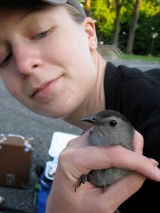I’m interested in how animals respond to changing environments, and in particular how human modifications to the landscape such as urban development can drive the evolution of various species. As a behavioral ecologist, my primary focus is on how animals’ behavioral responses to their environment affect their individual fitness and what these effects mean for the population as a whole. I look at how animals interact with both their physical and social environments, including members of their own species as well as other species. Current research in my lab includes:
- Relationships between parental nest defense behavior and nestling age and health in eastern bluebirds and tree swallows
- Impacts of human-associated environmental disturbances on birds’ choice of nest location and breeding success
- Nest predator community composition and behaviors in urban vs. rural areas
- The potential of cemeteries to support and preserve biodiversity across varying degrees of urbanization, and the impacts that age, size, landscaping, and other cemetery features may have on this potential.
Previously, I've also investigated the effects of urbanization on birdsong, the evolution and maintenance of population-specific differences in aggressive behavior (with Joel McGlothlin, Ph.D., Virginia Tech), environmental factors that predict foraging activity in squareback marsh crabs, and impacts of light and sound on hunting success in tarantulas (with Jason Davis, Ph.D.). I've also collaborated with colleagues in Biology and Information Technology to develop and use automated bird feeders to collect data on songbird foraging behaviors and social interactions across environments and seasons.
Students involvement is key to all of my projects, and work occurs throughout the year, in both the lab and the field. Contact me if you’re interested in getting involved!
